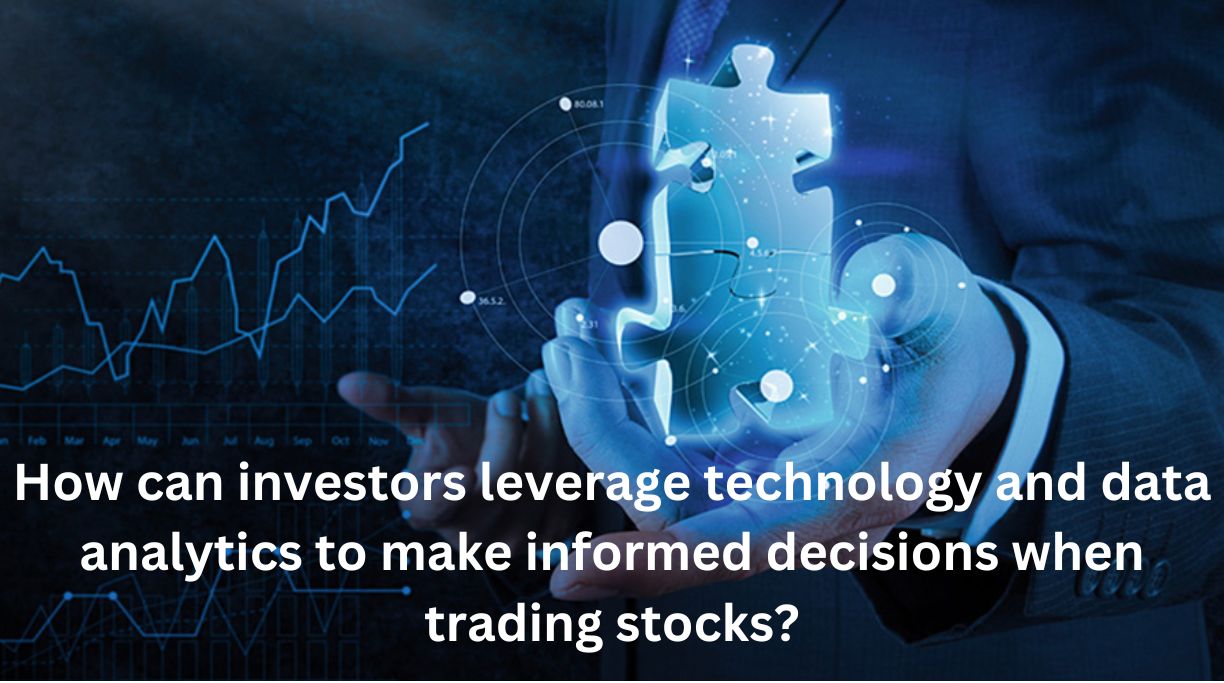Stock market investing may be exciting and intimidating at the same time. Since the development of technology, investors have had access to a wealth of resources and tools that can greatly improve their decision-making. In order to successfully negotiate the intricacies of the stock market, investors can make use of technology and data analytics, as we will explore in this article.
How Does Technology Affect Stock Trading?
Trading Algorithms and Automation
The foundation of efficiency in stock trading is now automation. The days of placing and executing orders by hand are long gone. Investors today use automated algorithms that can execute trades faster and more precisely than a human could. As a branch of automation, algorithmic trading uses sophisticated algorithms to assess market circumstances and carry out deals automatically. By doing this, human error is eliminated and trades are made at the best possible time, reacting instantly to market swings.
Current Market Information and News
In the stock market, where prices can fluctuate rapidly, promptness is essential. Investors who have access to real-time news and market data are better equipped to make snap decisions. Technology offers a constant flow of data for watching stock prices, keeping an eye on market patterns, and learning about world events that can have an impact on financial markets. With the help of this real-time information, traders may quickly modify their plans, take advantage of favourable circumstances, and manage possible risks.
What is Technology-Assisted Risk Management?
Recognising and Reducing Hazards
Thanks to technology, investors may now discover possible dangers by analysing large amounts of data using sophisticated analytics tools. These tools use machine learning and algorithms to identify trends that point to potential stock vulnerabilities, economic downturns, or market volatility. Investors can diversify their portfolios, modify their plans, and take proactive steps to protect their investments by proactively detecting risks. Additionally, technology makes it easier to analyse portfolios in real time, giving investors the ability to be alert to abrupt changes in market conditions. Investors can respond quickly and make proactive decisions by being swiftly notified about potential hazards through automated alerts and notifications.
Determining Risk Parameters and Stop-Loss Orders
The use of stop-loss orders and risk criteria is one of the main risk management strategies made possible by technology. To reduce possible losses, investors might establish preset price thresholds at which they will automatically sell a stock. This automation offers a disciplined approach to risk management by preventing emotions from impairing judgement during market changes. Technology also makes it possible for investors to set up extensive risk parameters that are specific to their investing objectives and risk tolerance. These constraints may include things like the maximum permitted loss on a portfolio, sector exposure, or restrictions on the concentration of any one stock. By utilising technology to formulate and implement these guidelines, investors create a methodical and regulated approach to risk management.
Diversification strategies: what are they?
Using Technology to Diversify a Portfolio
Historically, portfolio diversification has been achieved by distributing investments among several industries, geographical areas, and asset classes. Modern technology elevates this tactic to new levels by providing quantitative techniques that find the best possibilities for diversification by analysing large datasets. Sophisticated algorithms evaluate past performance, current market conditions, and risk variables, allowing investors to build diversified portfolios with data-driven judgements. Artificial intelligence-driven robo-advisors have become more and more well-known for their capacity to automatically create and manage diversified portfolios. These systems optimise portfolio allocation for maximum diversity by taking into account an investor’s risk tolerance, financial objectives, and market conditions through the use of sophisticated algorithms.
Examining Dependencies and Correlations
A sophisticated understanding of the interactions between various assets in a portfolio is made possible by technology. To examine relationships and correlations between different stocks, bonds, and other assets, investors employ sophisticated analytics techniques. This detailed research reveals possibilities and hazards that are concealed from view using conventional approaches. Investors can create portfolios that are resistant to market shocks by selecting assets with low or negative correlations and those that move in tandem during market swings. Real-time updates on these correlations are made possible by technology, which enables investors to dynamically modify their portfolios in response to changes in the market.
Read Also:
- What role does diversification play in building a resilient investment portfolio, particularly in the stock market?
- How can content planning enhance the digital marketing strategy for Real Estate Investment?
- How does the current geopolitical landscape influence investment strategies, and what precautions should investors take in response to these geopolitical factors?
Advanced Tools for Technical Analysis: What Is It?
Tools and Indicators for Charting
For investors looking for a visual depiction of price movements and trends, charting tools are invaluable. A range of chart types, such as line, bar, and candlestick charts, are available on advanced systems. Investors can use these tools to recognise trends, trendlines, and possible levels of support and resistance. Because indicators offer more levels of analysis, they further augment the capabilities of charting tools. Among the often utilised indicators are moving averages, Bollinger Bands, and the Relative Strength Index (RSI). These indicators support traders in understanding market dynamics, seeing overbought and oversold levels, and spotting possible trend reversals.
Knowing Technical Signals to Make Informed Decisions
Technical signals are indications and price charts that are analysed to provide direction for making decisions. These indications include a variety of patterns, including trend reversals, double tops or bottoms, and head and shoulders. These signals are used by investors to decide what to purchase or sell, to determine when to enter or depart the market, and to efficiently manage risk. Technical analysis now includes a new dimension thanks to machine learning and artificial intelligence. Large datasets can be analysed by these technologies at rates faster than human comprehension, revealing complex patterns and producing insightful predictions. These insights can be used by traders to make better decisions and anticipate changes in the market.
In stock trading, what does artificial intelligence mean?
Applications of Machine Learning
A form of artificial intelligence called machine learning gives stock traders the capacity to examine enormous datasets and spot patterns that could escape human scrutiny. Machine learning applications offer predicted insights into market patterns, price fluctuations, and possible investment possibilities through algorithms that are constantly learning and adapting. These applications, which give investors a quantitative advantage in decision-making, span from clustering techniques to predictive modelling. Machine learning algorithms are able to forecast depending on changing market conditions, find correlations in previous stock data, and analyse historical stock data. By using data to inform decisions, this data-driven strategy improves forecast accuracy and helps investors stay ahead of market changes and make timely, well-informed choices.
Analysing Sentiment for the Market
AI in stock trading goes beyond numerical data by using sentiment analysis to determine the mood of the market. This is analysing textual data such as news stories, social media posts, and other data to determine the overall sentiment of investors. Market sentiment can be classified as bullish, bearish, or neutral by sentiment analysis algorithms, which can offer important insights into future market movements. Investors can predict changes in market sentiment before they are reflected in stock prices by using sentiment research to grasp the human aspect. By taking a proactive stance, trading tactics can be strategically adjusted, improving the capacity to profit from new trends or reduce the dangers associated with unfavourable sentiment.
Conclusion
A new era in stock trading has been brought about by artificial intelligence, where sentiment analysis is used to interpret market sentiment and machine learning is used to deliver predictive insights. This dynamic convergence of technology improves decision-making, enabling investors to move with agility and foresight through the market’s intricacies. Artificial intelligence (AI) has the potential to significantly impact stock trading in the future by combining data-driven techniques with a thorough awareness of market sentiment to make more strategic and well-informed investing decisions.
FAQs
1. What is the role of technology in risk management for stock trading?
Technology plays a crucial role in risk management by providing advanced analytics tools to identify, assess, and mitigate risks. Automated systems and real-time monitoring empower investors to make proactive decisions in response to market fluctuations.
2. How does diversification benefit investors, and how can technology enhance this strategy?
Diversification minimizes risk by spreading investments across different assets. Technology enhances this strategy by offering quantitative tools that analyze vast datasets, helping investors make data-driven decisions for optimal portfolio allocation.
3. What are the key components of technical analysis tools, and how do they aid decision-making in stock trading?
Technical analysis tools include charting tools, indicators, and the interpretation of technical signals. These tools visually represent market dynamics, provide insights into trends, and offer signals for informed decision-making in stock trading.
4. How does Artificial Intelligence contribute to stock trading, particularly through machine learning applications?
AI, specifically machine learning, empowers stock traders with predictive insights by analyzing vast datasets and identifying patterns. Machine learning applications enhance decision-making by providing quantitative analysis and forecasting based on historical data.
5. What is the significance of sentiment analysis in stock trading, and how does it complement numerical data?
Sentiment analysis gauges market sentiment by assessing textual data from news articles and social media. It complements numerical data by offering insights into the collective mood of investors, aiding in anticipating shifts in market sentiment for strategic decision-making.








